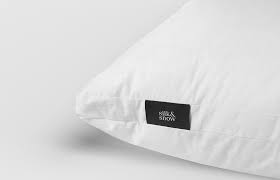5 THINGS TO KNOW ABOUT HYPOALLERGENIC PILLOWS
Pillows are more than just fluffy accessories for your bed; they play a significant role in ensuring a good night’s sleep and healthy sleep position. However, for individuals prone to allergies, the wrong pillow can exacerbate their symptoms, leading to discomfort and disturbed sleep. This is where hypoallergenic pillows come into play.
In recent years, hypoallergenic pillows have gained popularity for their ability to minimize allergic reactions and provide a healthier sleeping environment. In this comprehensive guide, we’ll explore 5 things you need to know about hypoallergenic pillows, from what they are to their benefits and how to choose the right one for you.
Table of Contents
Understanding Hypoallergenic Pillows
Hypoallergenic pillows are specifically designed to reduce the risk of allergic reactions triggered by dust mites, mold, mildew, pet dander, and other common allergens, which love to call your pillows home. They are made from materials that are less likely to cause allergic symptoms in sensitive individuals. Those materials are often natural and have natural hypoallergenic properties.
While no pillow can be entirely allergen-proof, hypoallergenic pillows are crafted to minimize exposure to potential allergens, making them suitable for allergy sufferers.
Materials Used in Hypoallergenic Pillows
Several materials are commonly used in hypoallergenic pillows, each offering unique properties:
1- Memory Foam: Memory foam pillows are popular for their ability to conform to the shape of your head and neck, providing personalized support. They are resistant to dust mites and mold, making them an excellent choice for allergy sufferers. Often, memory foam hypoallergenic pillows are made of memory foam scraps or shredded memory foam. Higher-end pillows like this one, however, are made of cubed memory foam.
Hypoallergenic properties: typically made from polyurethane foam, which is naturally resistant to allergens such as dust mites and mold; dense and tightly packed structure that creates a barrier against dust mites, pollen, pet dander, and other allergens; closed-cell construction, which means that its structure is less porous compared to other pillow materials; easy to clean and maintain
2- Latex: Latex pillows are derived from natural rubber, made from the sap expressed from rubber trees, and are naturally resistant to dust mites and mold. They offer firm support and are hypoallergenic pillows, especially as rubber trees are naturally insect- and bug-repellent, and do not require the use of such chemicals. Latex pillows are also a very sustainable option.
Hypoallergenic properties: naturally resistant to dust mites, mold, and mildew; natural latex is free from harmful chemicals and additives, making it a safer option for individuals with chemical sensitivities or allergies; open-cell structure that promotes airflow and ventilation, which inhibit the growth of mold and bacteria; natural antimicrobial properties that help inhibit the growth of bacteria and fungi
3- Bamboo: Bamboo pillows are made from bamboo-derived materials known for their breathability and moisture-wicking properties. Bamboo is naturally hypoallergenic and resistant to dust mites, making these hypoallergenic pillows suitable for allergy-prone individuals. Just as latex pillows, bamboo is a fast-growing tree, which does not require cutting to express its pulp and process into bamboo fiber. They are naturally insect-repellent as well, and as the pulp is processed into fiber in closed-loop cycles, it is a sustainable, and water-non-intensive material to produce, soft on your health and the environment.
Hypoallergenic properties: naturally resistant to dust mites, mold, and other common allergens; breathability helps regulate temperature by dissipating excess heat and moisture, keeping the sleep surface dry and preventing the buildup of sweat and moisture; natural antibacterial agents that inhibit the growth of bacteria on the pillow’s surface
4- Microfiber: Microfiber pillows are filled with tiny polyester fibers that mimic the softness and loft of down. They are hypoallergenic, resistant to dust mites, and machine washable, making them a practical choice for allergy sufferers as they are easy to keep clean night after night.
Hypoallergenic properties: made from synthetic materials such as polyester, which are naturally hypoallergenic and does not harbor allergens such as dust mites, pollen, or pet dander; tightly woven structure that prevents allergens from accumulating within the pillow; easy to clean and maintain
5- Organic Cotton: Organic cotton pillows are made from cotton grown without the use of pesticides or chemicals. They are naturally hypoallergenic pillows, as well as breathable, reducing the risk of allergic reactions while promoting airflow for a cooler sleep surface.
Hypoallergenic properties: grown without the use of synthetic pesticides, fertilizers, or genetically modified organisms (GMOs), hence free from harmful chemicals and toxins that can trigger allergic reactions or sensitivities; naturally hypoallergenic; absence of chemical residues and irritants, great for individuals with allergies, asthma, or sensitive skin
Benefits of Hypoallergenic Pillows
Choosing a hypoallergenic pillow offers several benefits, especially for individuals with allergies, asthma, and skin conditions:
1. Reduced Allergic Reactions:
Hypoallergenic pillows are made from materials that are less likely to harbor allergens or provoke allergic reactions. The materials listed above are chosen for their hypoallergenic properties (often natural), meaning they are less likely to trigger allergies compared to materials like down feathers, which can harbor dust mites and other allergens.
Many hypoallergenic pillow materials are naturally resistant to common allergens such as dust mites, mold, mildew, and pet dander. For example, memory foam and latex are inherently less hospitable to dust mites and mold growth compared to traditional pillow materials like down or cotton. By using these allergen-resistant materials, hypoallergenic pillows minimize the presence of allergens in the sleeping environment.
Individuals with allergies or sensitivities may find relief when using hypoallergenic pillows because these pillows minimize exposure to potential allergens. By reducing contact with allergens such as dust mites, mold spores, and pet dander, hypoallergenic pillows can help alleviate allergic symptoms such as sneezing, congestion, itching, and watery eyes, leading to a more comfortable and restful sleep experience.
2. Improved Sleep Quality:
Hypoallergenic pillows can contribute to improved sleep quality in several ways. But breathability and temperature regulation is a big reason. Certain hypoallergenic pillow materials, such as rubber- and bamboo-derived fabrics, are known for their natural breathability and moisture-wicking properties.
These materials promote airflow and heat dissipation, helping to regulate body temperature and create a cooler sleep environment. By preventing overheating and excessive sweating, hypoallergenic pillows contribute to a more comfortable and undisturbed sleep.
3. Enhanced Comfort and Support:
Many hypoallergenic pillows are designed to offer superior comfort and support for the head and neck. Materials such as memory foam, latex, and microfiber conform to the contours of the sleeper’s head and neck, providing customized support and alleviating pressure points. By promoting proper spinal alignment and reducing discomfort, hypoallergenic pillows help individuals achieve a more comfortable and restorative sleep.
4. Durability:
Hypoallergenic pillows are often made from high-quality materials that are more resistant to wear and tear. With proper care, these pillows can maintain their shape, support, and hypoallergenic properties for a longer period of time than most regular pillows. By investing in a durable hypoallergenic pillow, you can enjoy consistent sleep quality and comfort over time without the need for frequent replacement.
5. Peace of Mind:
For individuals with allergies or sensitivities, the peace of mind that comes with using hypoallergenic pillows can positively impact sleep quality. Knowing that their pillow is less likely to trigger allergic reactions allows individuals to relax and sleep more soundly, free from worries about allergen exposure.
How to Choose the Right Hypoallergenic Pillow
When shopping for a hypoallergenic pillow, consider the following factors to ensure you select the right one for your needs:
- Materials: Choose a material that suits your preferences and addresses any specific allergies or sensitivities you may have. Check Materials section above to find our more about each material’s unique properties.
- Firmness: Select a pillow firmness level that provides adequate support for your head and neck while aligning your spine properly. Firmness preferences vary from person to person and is heavily influenced by your sleeping style, so choose according to your unique preferences and any existing neck or back issues.
- Size and Shape: Consider the size and shape of the pillow based on your sleeping position and personal preferences. Standard, queen, and king sizes are available, along with various shapes such as traditional, contour, and cervical pillows designed for specific sleeping needs.
- Maintenance: Check the care instructions for the pillow to ensure it is easy to clean and maintain. Some hypoallergenic pillows are machine washable, while others may require spot cleaning or professional care.
- Warranty and Return Policy: Look for pillows that come with a warranty or satisfaction guarantee, allowing you to test the pillow and return it if it doesn’t meet your expectations. A generous return policy provides added peace of mind when making your purchase.
Tips for Maintaining Hypoallergenic Pillows
To prolong the life of your hypoallergenic pillow and ensure optimal hygiene, follow these maintenance tips:
1. Use Pillow Protectors: Invest in hypoallergenic pillow protectors to create an additional barrier against dust mites, allergens, and stains. Wash the protectors regularly to keep them clean and free of allergens.
2. Wash Regularly: Follow the care instructions provided by the manufacturer to wash your pillow regularly. Most hypoallergenic pillows can be machine washed or spot cleaned to remove dirt, sweat, and allergens. If the whole pillow cannot be thrown in the washing machine, check if the pillow cover can. When selecting a hypoallergenic pillow, favor those with zippable covers, for that reason!
3. Air Out: Periodically air out your pillow by placing it in a well-ventilated area or outdoors on a sunny day. This helps to freshen the pillow and reduce the buildup of moisture and odors.
4. Replace When Necessary: Monitor the condition of your hypoallergenic pillow and replace it as needed. Over time, pillows can lose their shape and support, diminishing their effectiveness at providing a comfortable and allergen-free sleep surface.
Non-Biased Reviews' Favorite Hypoallergenic Pillows
Hypoallergenic Pillows - What You Need To Know
FAQ
Most frequent questions and answers
Hypoallergenic pillows are specially designed pillows crafted from materials that are less likely to trigger allergic reactions. They are created to minimize exposure to common allergens such as dust mites, mold, mildew, and pet dander, making them suitable for individuals with allergies or sensitivities.
Regular pillows may contain materials that can exacerbate allergic symptoms, such as down feathers, which can harbor dust mites and other allergens. In contrast, hypoallergenic pillows are made from materials that are hypoallergenic and resistant to common allergens, providing a healthier sleeping environment for allergy sufferers.
While no pillow can guarantee complete allergen protection, hypoallergenic pillows are designed to minimize exposure to potential allergens, thereby reducing the risk of allergic reactions. By choosing a hypoallergenic pillow and following proper maintenance practices, individuals can significantly alleviate allergic symptoms and enjoy a more comfortable sleep experience.
Hypoallergenic pillows are crafted from a variety of materials, including memory foam, latex, bamboo, microfiber, and organic cotton. Each material offers unique properties such as breathability, moisture-wicking, and resistance to dust mites and mold, catering to different preferences and sensitivities.
When selecting a hypoallergenic pillow, consider factors such as material, firmness, size, shape, and maintenance requirements. Choose a material that suits your preferences and addresses any specific allergies or sensitivities you may have, and select a firmness level and size that provide optimal comfort and support for your sleeping position.
More Sleep Resources

What Is Luften | How, When, How Much, and Everything Else You Should Know
WHAT IS LUFTEN What, How, When, And Everything Else If you are looking for simple, yet effective, ways to boost your health, improve your sleep,

Best Pillow For Sore Neck
BEST PILLOW FOR SORE NECK Our Top Picks and Expert Tips for Pain-Free Sleep A sore neck can disrupt your entire day—and a bad pillow

5 Benefits of Memory Foam Mattresses | Why They’re Worth Considering for Better Sleep
5 BENEFITS OF MEMORY FOAM MATTRESSES Why They’re Worth Considering for Better Sleep Memory foam mattresses have become a go-to choice for sleepers seeking comfort,

How Does Sleep Improve Memory?
HOW DOES SLEEP IMPROVE MEMORY? Make Sleep a Priority for Better Memory In today’s fast-paced world, where productivity is often prioritized over rest, many underestimate
How do hypoallergenic pillows differ from regular pillows?
Regular pillows may contain materials that can exacerbate allergic symptoms, such as down feathers, which can harbor dust mites and other allergens. In contrast, hypoallergenic pillows are made from materials that are hypoallergenic and resistant to common allergens, providing a healthier sleeping environment for allergy sufferers.
Are hypoallergenic pillows effective at reducing allergic reactions?
While no pillow can guarantee complete allergen protection, hypoallergenic pillows are designed to minimize exposure to potential allergens, thereby reducing the risk of allergic reactions. By choosing a hypoallergenic pillow and following proper maintenance practices, individuals can significantly alleviate allergic symptoms and enjoy a more comfortable sleep experience.
What exactly are hypoallergenic pillows?
Hypoallergenic pillows are specially designed pillows crafted from materials that are less likely to trigger allergic reactions. They are created to minimize exposure to common allergens such as dust mites, mold, mildew, and pet dander, making them suitable for individuals with allergies or sensitivities.
What materials are used in hypoallergenic pillows?
Hypoallergenic pillows are crafted from a variety of materials, including memory foam, latex, bamboo, microfiber, and organic cotton. Each material offers unique properties such as breathability, moisture-wicking, and resistance to dust mites and mold, catering to different preferences and sensitivities.
How do I choose the right hypoallergenic pillow for me?
When selecting a hypoallergenic pillow, consider factors such as material, firmness, size, shape, and maintenance requirements. Choose a material that suits your preferences and addresses any specific allergies or sensitivities you may have, and select a firmness level and size that provide optimal comfort and support for your sleeping position.
Share this deal with a friend!

Laura Georgieff
Laura is a mother of three who did not sleep through the night for the first 5.5 years of her kids' lives. She is passionate about sleep quality and loves sharing her experience and knowledge of all thing bedding! It is her mission to help you make the best decisions when it comes to sleep and help you get the best deal on the market!





